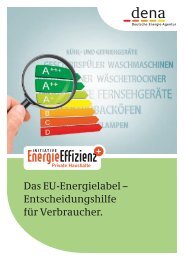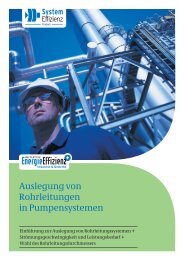biogaspartner – a joint initiative.
biogaspartner – a joint initiative.
biogaspartner – a joint initiative.
Create successful ePaper yourself
Turn your PDF publications into a flip-book with our unique Google optimized e-Paper software.
Market.Development.in.Germany..<br />
2.3.Political.framework.for.biogas.injection.in.Germany.<br />
In context with the implementation of the Integrated Energy<br />
and Climate Programme of august 23, 2007 by the German<br />
Federal Government, the general conditions for biogas<br />
upgrade and feed-in were reviewed and amended. In the Gas<br />
network access ordinance, effective from april 12, 2008, in<br />
article 41 a) the target has been defined: By 2020, 60 billion kWh<br />
biomethane are to be fed into the gas grid each year, and by<br />
2030 100 billion kWh biomethane each year.<br />
since upgraded and fed-in biomethane is currently not on a<br />
competetive basis with natural gas, politics employ various<br />
measures and support schemes to develop demand in the<br />
markets. next to its application in the heat market, biomethane<br />
is also used for combined heat and power as well as in natural<br />
gas-dedicated vehicles.<br />
Due to the diverse stages along the value chain and different<br />
processes, many diverse regulations are employed to promote<br />
the injection of biogas in Germany. The most important ones<br />
are highlighted in the following chapter.<br />
Biomass.Ordinance.(BiomasseV).<br />
Effective since 2001, the Biomass ordinance directs the application<br />
of the renewable Energy sources act (EEG )and sets<br />
guidelines on which materials are biomass, which technologies<br />
for power generation from biomass are within the scope of application<br />
of the EEG, and which environment requirements are<br />
to be obeyed when generating power from biomass.<br />
Biomasses, according to the biomass regulation, are energy<br />
sources from phyto- and zoo-mass. This also includes secondary<br />
and by-products, residues and waste whose energy content is<br />
made up of phyto- and zoo-mass.<br />
20 B I o G a s P a r T n E r <strong>–</strong> a j o I n T I n I T I a T I v E<br />
The definition of biomass in Paragraph 2 (3) nr. 5 also includes<br />
biogas generated by anaerobic fermentation. not included in<br />
biomasses, however, is biogas which has been produced from<br />
the following material (according to Paragraph 3 nr. 3, 7, 9):<br />
mixed settlement waste from private households<br />
mud and sediments, animal by-products according to<br />
article 2 paragraph. 1, (a) of the regulation, i. e. no. 1774/2002<br />
by the EU Parliament and the Council of october 3, 2002<br />
with hygiene regulations for byproducts not meant for human<br />
consumption.<br />
next to the application of biomass according to this regulation,<br />
the renewable Energy sources act also allows the utilisation of<br />
other biomasses. For the portion of power generated from other<br />
biomasses, however, no state-guaranteed feed-in tariffs can be<br />
claimed. The portion of this other biomass used must be proven<br />
with the help of a charge material diary produced by the plant<br />
operator.<br />
Renewable.Energy.Sources.Act.(EEG).<br />
The renewable Energy sources act first became effective on<br />
april 1, 2000. In 2004, it was amended for the first time. on june<br />
6, 2008, the German Federal Parliament decided the second<br />
amendment of the EEG, which became effective in january<br />
2009.<br />
The main purposes of the EEG are the protection of our climate,<br />
a sustainable energy supply, a minimisation of the economic<br />
costs of energy supply, the protection of fossil resources and the<br />
further development of renewable power generation technologies.<br />
In this context, the percentage of renewable energies in<br />
power supplies is to be raised to 30 percent by 2020. To achieve<br />
this goal, the EEG gives plants generating power from renewable<br />
energy sources priority to the public power grids. also, it<br />
regulates preferred sales and transmission as well as a guaranteed<br />
feed-in tariff. The feed-in tariff depends on the technology.<br />
next to biomass (biogas), hydropower, wind power and solar<br />
power as well as disposal, sewage and mine gas are supported.









